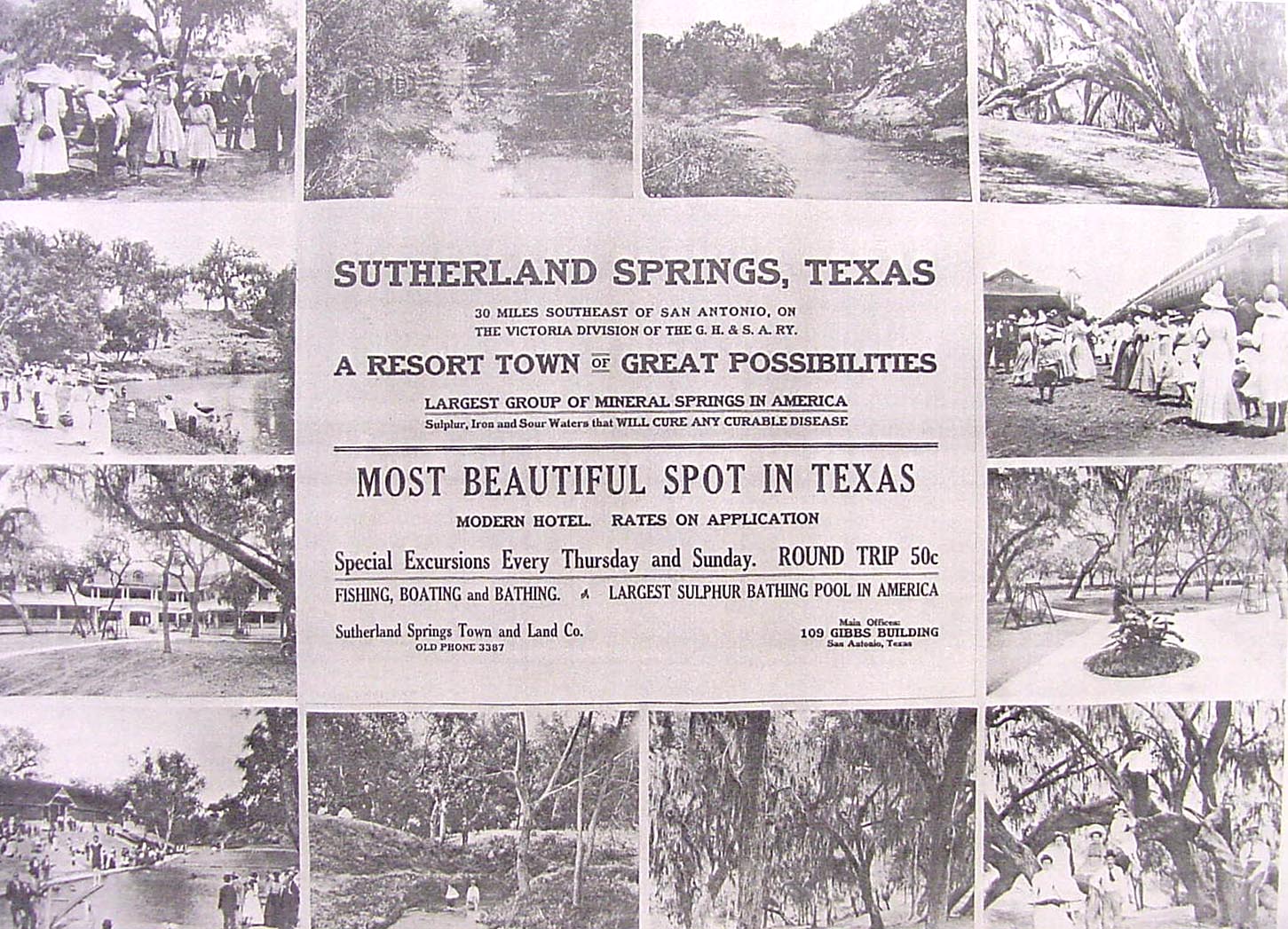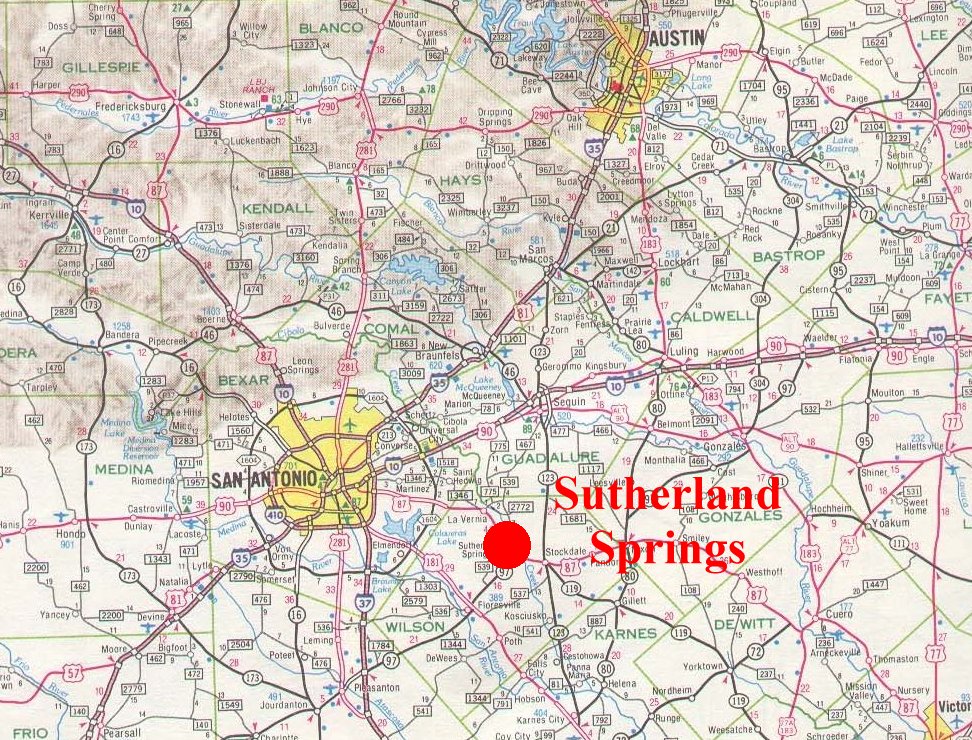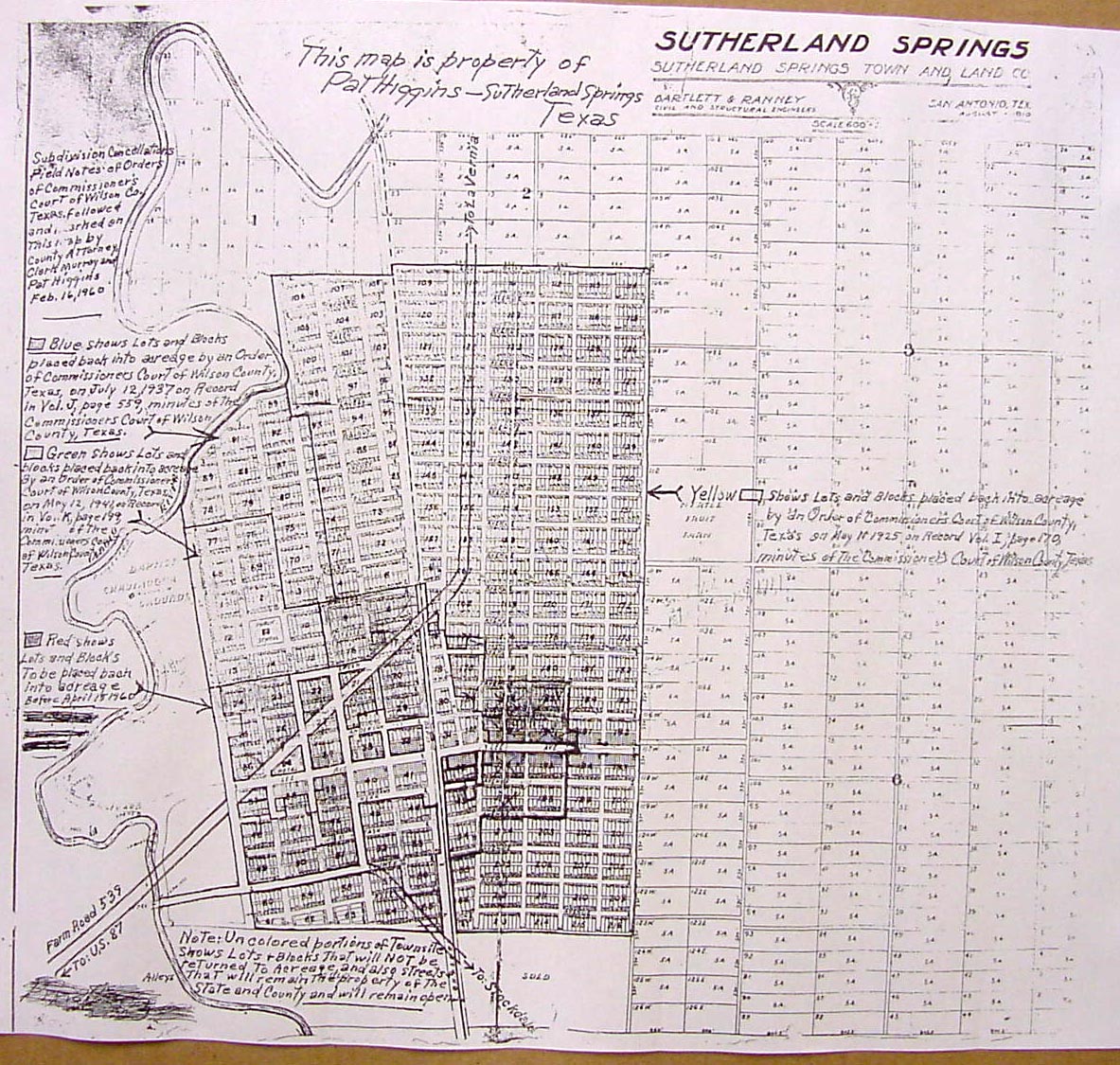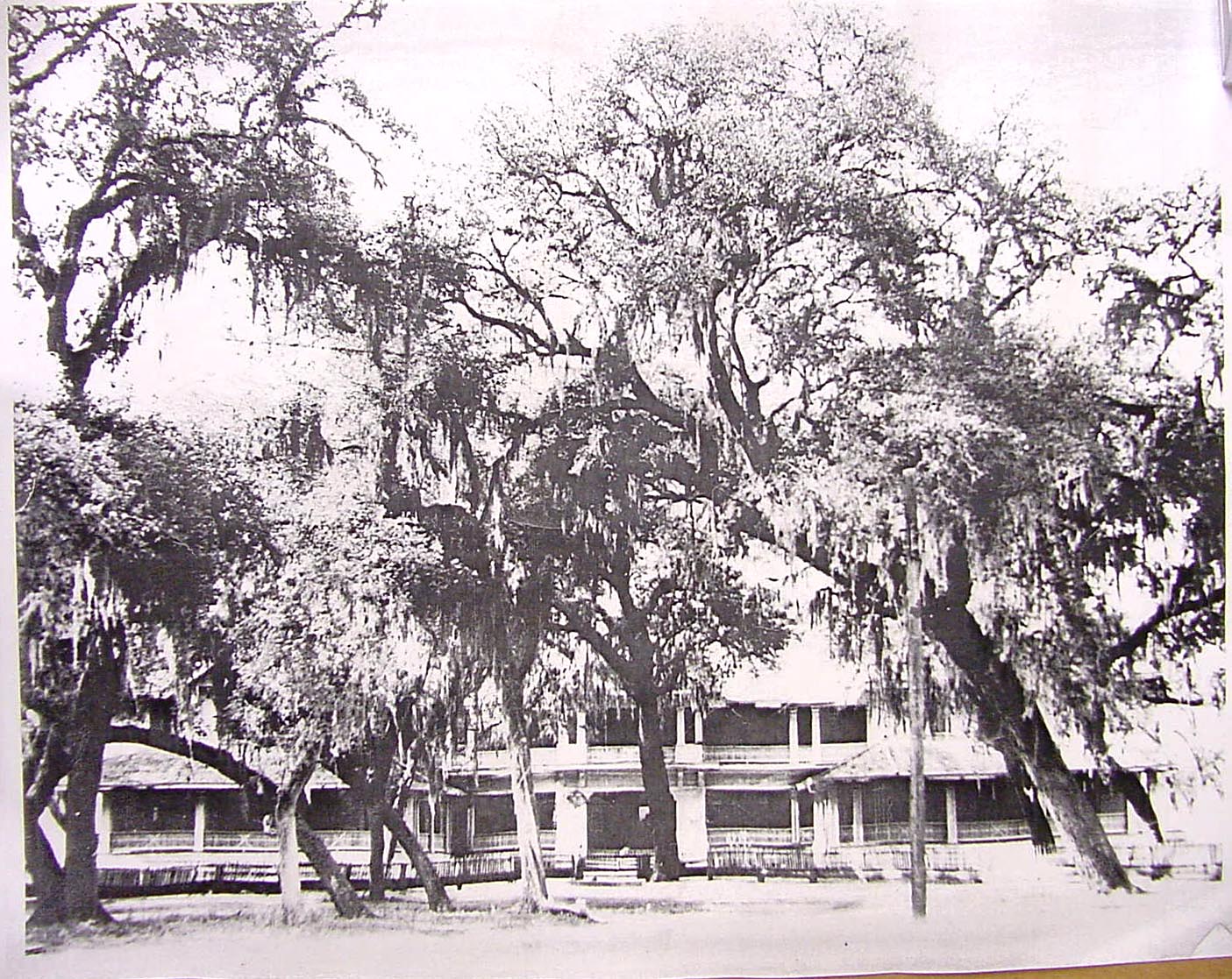

Palo Alto College
San Antonio, Texas
Small Town History: Sutherland Springs
Michael Cavazos ~ Spring 2002History 1302
Hines
Click on images to see larger view.


Nestled on the banks of
the Cibolo Creek, Sutherland Springs has been called the Saratoga of the South.
It has a wealth of natural resources and a natural beauty far from that of
typical south central Texas scrub land. Sutherland Springs is truly a gem often
overlooked. The very idea that men settled this untamed portion of Wilson County
is a testament to the pioneer spirit of the mid 1800’s. Though there had been
several surveys and a few encampments, it is with good reason that Dr. John
Sutherland is given credit for founding Sutherland Springs. He settled the area
in 1849. Sutherland Springs lies on a portion of the Manuel Tarin land grant.
Presently, U.S. Highway 87 and FM 539 intersect in Old Town Sutherland Springs.
In the mid 1800’s, Old Town lay at the intersection of two of the areas busiest
trails, the Goliad trace and the Chihuahua Road. In 1860, the population was
rising and employment in agriculture, wagon trade and tourism made Sutherland
Springs a thriving community. It was also in 1860 that Sutherland Springs was
designated as the provisional seat of the newly founded Wilson County which was
defined February 13, 1860.
The completion of the Galveston, Harrisburg and San Antonio Railway helped boost trade and with the construction of the San Antonio and Gulf shores railway on Cibolo Creek. Tourism in 1895 was a real future for this hard-working town. On December 12, 1907 S.W. Magill, Semp Russ, A.S. Morton, T.C. Washington, E.G. Millikan, H.A. Spear, Harry Redan, Henry Rugeby, and J.L. Kerr purchased 1,000 acres (Read, Tambria). It was then sold in 1908 to the Sutherland Springs Development Corporation.


By then, the Sutherland Springs hotel had opened in mid to late 1908 on the west side of the Cibolo and in 1910 the Sutherland Springs Development Corporation surveyed New Sutherland Springs near Sunshine Depot. Many of the businesses of Old Town followed. From 1908-1913 New Town was booming. The 52 room hotel Sutherland offered conveniences of a new era: running water, sewage and a Delco system of batteries and generators suppling electricity to the entire hotel (Sprague).
New town prevailed, "by June 1911, the town consisted of four hotels and boarding houses, two restaurants, three real estate companies, four physicians, two bakeries, one grocery, one gereral store, one poolroom, one bank, two drug stores, one dry good store , two meat markets, one ice house, two lumber yards, one cotton gin, two blacksmiths, two barbers, and one stable (Valenza)." By October 1913 all this would change. A sudden storm’s rage was unleashed on Sutherland Springs and flooding filled the ever clear and calm springs with mud. Soon after the flood water receded, the owners sold out to T.J. Williams. Williams dredged the springs, built a dancing pavilion, a sanitarium, a bath house and a trolley from his park directly to the railroad, but the business flopped within a few short years. Then, most of the businesses moved to the original town site known as Old Town.
One cannot read about, speak about or visit Sutherland Springs without running into the name of Dr. John Sutherland. The Sutherland's ancestry can be linked to castle Dunrobin in the northern most county of Scotland. Very fitting is the Sutherland clan's motto "Sans Peur" or "without fear." John was born to a Revolutionary war captain in 1792 in Danville, Virginia. In 1805 the Sutherland family was on the move to Tenessee where John's father worked on a ferry on the Clinch River. John entered the working life of a store clerk, working his way up very quickly. In 1816 he married Diane Kennedy and moved to Decatur, Alabama. By 1824 he was the president of a bank. The bank failed miserably and in 1826 John and his family moved to Tuscumbia, Alabama to form a partnership in a small merchantile with his brother George. Again John's business failed, feeling a little beat, George left Alabama and joined Austin’s Colony with an eye to homestead for the both of them. John stayed in Tuscumbia.
In 1827, John's wife Diane passed away. John was left alone. Determined to take care of his aging father and daughter, he began attending medical school. He had a facination with treating disease with steam and local herbs.
John married Ann Bryant Lane, opened a practice in Tuscumbia and was doing well for his family, but Texas called to him. He was again on the move on December 12, 1835. He swore allegiance to Texas and became a citizen. He was joined by his brother George’s son William and headed off to the Alamo to help the sick. While out riding he was injured and could not fight, so Col. Travis sent him to bring help, but he returned too late. Lying among the dead was his nephew William De Trest Sutherland. After the Revolution, John settled in Egypt. Then, his second wife died in 1840. In the mid 1840’s John married his third wife Ann Dickson and in 1849, they moved into present day Sutherland Springs.
John immediately recognized the powers of the springs and set up shop. Though he did not attain great wealth he did establish the postal service of Sutherland Springs, (coincidentally the longest continuously running post office in Texas). He became Postmaster, Justice of the Peace and opened the first school and platted the townsite, all the while practicing medicine.
Joseph H. Polley was born in 1792 in upstate New York. The son of a farmer and dairyman, Polley was discontented with his meager existence and yearned to explore his own talents. At age 15, he signed up with the New York militia and served as a teamster during the war of 1812. This was a defining moment in Polley’s life. After being discharged from the service he found himself in Missouri. There he met up with a father and son, Moses and Stephen Austin. He traveled with the Austins to Texas and served as the first sheriff of "Austin’s Colony". He was also at "the runaway scrape" as a non-combatant guarding civilians. By 1923 he married Mary Bailey and moved to San Felipe. There Polley and his wife’s business savvy begins to show. They opened their house as a "public house" where for a fee, a traveler could take in the atmosphere, relax and be waited on hand and foot. The key to Polley’s first success-- only one of many for Polley-- was his ability to provide the rare luxuries most inns at the time could not. In fact, many customers stopped by simply to eat. A meal at the Polley home would consist of fresh beef, fresh vegetables and fruits from their own fields and the rarest fresh butter and cheese crafted by Polley who learned the trade growing up on a dairy farm.
Though his inn was succeeding, Polley already had his eye on something grander. He was granted land as a colonist, but could see the trend in settlements and began some cultivation of his land in areas that did not suit him. Once established he sold off the land he did not care for, choosing to keep the majority of his land in extremely diverse areas of Texas. In 1832, Polley moved the family back to the Brazoria district and by 1837 he reportedly was in direct ownership of 10,000 acres scattered throughout south Texas. Being the astute business man that he was, he began buying up prime real estate in the Brazoria area and financed them with sales from his less-favored tracts. Meanwhile, revenues from boarders, sales of excess chickens, eggs, butter and cheese and of course his duties of a sheriff were keeping him ahead of the game.
On many instances, it is noted Polley paid with beef or would trade field work rather than cash. In 1847, Polley again moved his family to present day Sutherland Springs on the banks of the Cibolo. The major reason was economic, but was underlined with fear of diseases, such as cholera and typhoid. As his cattle business grew, so grew the need for more land and food for the cattle. Between the resources being tapped out on the Brazoria property and a new son-in-law, John James, who advised him on the new opportunities of an open untapped Mexican market. Polley built his new now farmed "White Wall" mansion. Polley’s cattle business blossomed and so did his generosity toward Sutherland Springs. An entire community was built and supported by him, funding schools and many businesses. He is remembered as one of the true inspirational testaments to a hard work ethic.
The economy in Sutherland
Springs has fluctuated over the years and several reasons have attributed to
this rise and crash cycle. One reason was rainfall as noted by David Nickels in
his thesis of the Biesen Bach site. He states "rainfall averages 27.89 inches,
but a great deal of variation in rainfall exists from year to year with 52.28
inches recorded in 1973 and 10.11 inches recorded in 1917." As you can imagine,
this has a great deal of impact on livestock and crops. The climate dictates
much of what can grow and with so many failed attempts to make a good living at
it. Many in the late 1800’s turned to tourism and general merchandise, but as
you have read this also has gone through its share of ups and downs.
As stated before, T.J. Williams bought Hotel Sutherland after the disastrous flood of October 1913 and restored the hotel. After adding a new sanitorium, a dance pavilion a bath house and a narrow gauge trolley, he had just about exhausted his funds and apparently by 1914, these natural springs began to lose their flair. Williams' wife died in 1923 and the hotel business failed, so Williams sold to Pattillo Higgins in 1935. Many people say Higgins neglected the building and was the cause of it’s demise. According to Tambria Read-Higgins, (Pattillo's great-grand-daughter), the hotel was actually bought with a gentlemen’s agreement that Pattillo would tear it down to use it for wood, but only after Williams passed away. In 1945 Pattillo Sr. sold to Pattillo Jr. and he tore the hotel down in late 1945. Very few of the buildings of New Town exist and the ones that do are in ruins. Luckily they are in the private ownership of the Higgins Read family which is committed to preservation and education on Sutherland Springs. As for the hotel, Higgins used the lumber to build a huge barn to aid in his production and experimentation with bufflo grass and other drought resistant strains of cattle fodder. Higgins’ grass farms proved to be a wonderful model for a modern well-managed farm. The remains of Hotel Sutherland are still standing, a bright red barn dwarfing its surroundings off Lee Avenue and FM 539.
Sutherland Springs has stood the test of time from its founding in 1849 by John Sutherland to the present. It has been a trial by fire-- sometimes almost literally-- after the devastating flood of 1913. The town bounced back slowly. Then in 1927 a huge fire broke out consuming several blocks of New Town. This disaster was followed by a flu epidemic in 1929 and the crusher, the Great Depression in the 1930's.
During the Great Depression, our old friend Pattillo Higgins Sr. kept plugging away and his son was just as persistent even inventing a useful piece of farm machinery called a "bug catcher." Because not only did it catch all the seeds in the grass it also caught all the bugs. The Higgins family has proved to be one of the most historically important families in Wilson County I have spoken with to date.
Between speaking with Tambria L. Higgins-Read and Beulah Wilson I can almost step back in time and feel the very essence of the place. Ms. Higgins-Read drove me through Sutherland Springs and speaking with her, one cannot help but feel that pioneer spirit of Sutherland Springs. She explained, "her grandfather's 'dittle patch' where he would experiment with coastal, oats, gordo, wheat, and pecan." He even tried out elephant grass, which still grows wildly today on her property.
Beulah Wilson, treasurer of the Sutherland Springs Historical Museum, also regaled me with many stories of Sutherland Springs as she guided me through the museum. One story in particular stood out, "On the final day of school before letting out for Christmas vacation December 19, 1949 the school burnt down. Little was salvaged and by 1938 the New/Old Town had consolidated, so this left Sutherland Springs without a public school."
The history of Sutherland Springs is very intermingled with its location, and its inhabitants are bound to the history as much as the history is bound to the land. Robert E. Lee stayed at the Polley Mansion an there he wrote his famous letter from "White Hall" on February 19, 1861. Driving by White Hall today you can almost feel the weight on Lee’s shoulders at Sutherland Springs as almost all its young men ran off to fight for the Confederacy. Sutherland’s son Jack went off to fight and served with the Confederacy. Fred Anderson has a picture on the wall of his great-grandfather, Stacy Anderson who was wounded at Turkey Creek, and eventually died in a Union P.O.W. camp. Even today as you drive through you can feel the south. Not the racist, hateful south but, a hardworking proud south. As I was driving along I saw a bumper sticker with a big rebel flag that read, "Pride not Prejudice." This sums it up Sutherland Springs is a community proud of its history and looking for its future.
The future of Sutherland Springs is uncertain. By the 1930s New Sutherland Springs was a ghost town and the Old town was hanging on by a thread. By the late 1950s there were only two businesses left. In 1956, oil was found and new hope was rekindled, but proved futile. Most who now live in Sutherland Springs do so to get away from the city and either work in San Antonio or Floresville. The young of Sutherland Springs go off to college and don’t come back. Sutherland Springs is fading away.
Works Cited Page
Almarez, Dr.Felix D.Jr.,et al. The Texas County Inventory
Project. Austin,Texas: Texas State Library, 1976.
Parenthetical note: (Almarez-information in the inventory lays down tracks of base information.)
Aneff, Patricia. ‘John Sutherland.’ Wilson County Centennial 1860-1960, A Souvenir, (a pamphlet).
Parenthetical note:(Aneff-This article is a wealth of information
and is very direct, very helpful with dates
& on John Sutherlands life.)
Gillard, Maude T. Wilson County Texas Rangers. 1st ed.
Texas : Locally printed, 1977.
Parenthetical note: (Gillard-Though I did not use this article
in my report I do recommend it for those
looking to gain a grander background on
Wilson County history.)
Jimenez, Diane, and George Southern. Wilson County History.
Dallas, Texas: Taylor, 1990.
Parenthetical note: (Jimenez and Southern 163-(I believe this
is another great source of information with
details that are otherwise left out of other
articles.)
Nickels, L. David. The Biesenbach Site (41WN88). San Antonio, Texas: UTSA, 2000
Parenthetical note: (Nickels- In his masters thesis on the Biesen Bach site, Nickels paints a beautiful picture of the past and present climate, biology, and botanic diversity of Sutherland Springs. By studing the rain cycles, the geologic make up and the past availability of food sources we see what a harsh environment the great men overcame. Proved to be very enlightening and entertaining.)
Meyr, Irma M. Cemeteries of Wilson County, Texas. Locally Published, property of Floresville Library, 2002.
Parenthetical note: (Meyr-In her presentation of the cemeteries of Wilson County Meyr’s booklet acted as a virtual checklist of historical figures. It is a very well organized and presented document.)
Shaw, Sandra L. ‘Sutherland Springs.’ Wilson County Centennial 1860-1960; A Souvenir, (a pamphlet).
Parenthetical note: (Shaw-Again this is a wonderful article giving a great chronology of Sutherland Springs. It was extremely helpful I cannot stress how much I loved this article.)
Smyrl, Vivian Elizabeth. The Handbook Of Texas Online. ‘Wilson County.’ 23 July.2001<http:www.tsha.utexas.edu/ handbook/online/articles/view/ww/hcw12.html>.
Parenthetical note: (Smyrl-There was not much I saw here that I couldn’t find in Shaws’ article, but never the less it was a well presented site.)
Sprague, Karen and Steve. Virtual Texan. ‘Texas Ghost Towns-Sutherland Springs.’ <http://www.star-traveler.
com/comm/virtual/springs.html>.
Parenthetical note: (Sprague-This is an exceptional site. I believe this is a great combination of good writing and research. It proved to be very informative, this was a virtual tour.)
Sutherland, John. The Fall of the Alamo. San Antonio, Texas:
Naylor, 1936.
Parenthetical note: (Sutherland 1-9 From his own mouth this is a great account of a Texas tragedy. I did not find much about Sutherland Springs, but could tell you a lot about John Sutherland.)
Read, Tambria. Personal interview.01 March 2002.
Parenthetical note: (If you need to know about the history of Sutherland Springs there is no better person to speak with. Not only is she dedicated to the history of Sutherland Springs, but she is a decendant of many of Sutherland Springs’ most colorful characters. Her great grand father was Pattillo Higgins of spindle top fame. Though she is always busy she went out of her way to help. Her recollection and stories passed down generation to generation are of historic importance. Even with a pile of information the size of a large horse she remains objective and is the first to tell both sides of a story. She is by far a model historian, citizen and a resource to be treasured to the community.)
Rettman, Paul. Records of wells and springs San Antonio area, Texas: Edward’s Underground Water District,1969.
Parenthetical note: (Rettman-I did not use this source, but included it. It shows the trend in our water table an gives you the reader a chance to feel out how important water is to the community and economy.)
Troesser, Kate Wong. ‘Sutherland Springs, Texas.’ Texas Escapes. 1998-99.2001-02<http://www.texas escapes.
com/Towns/Texas/ghost/towns/sutherlandspringstexas /sutherlandspring.html>.
Parenthetical note: (Troesser-A very useful website almost like a maze, one fact leads to another it is also a good travel plan.)
Tyler, Ron.,Douglas E.Barnett, Roy R. Barkley, Penelope C.
Anderson, and Mark F. Odintz. The New Handbook of Texas. Vol.6, The Texas State Historical Association,
1996. 6 vols.
Parenthetical note: (Tyler, Barnett, Barkley, Anderson, and Odintz 154-156 A very basic factual document, a great base of information.)
Valenza, Janet. Taking the water in Texas: springs, spas, fountains of youth. Austin, Texas: University of Texas Press, 2000.
Parenthetical note: (Valenza-A critical source I feel even if you are not a history fan the sheer nostalgia of by gone days will engage the most hardened of readers. This book is essential in understanding the medical mentality of the late 1800’s. I cannot stress how useful and practical this book is.)
Return to Small Town Research Projects Index